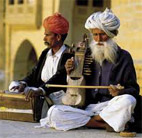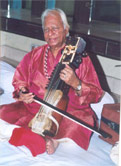SARANGI
History
One of the most popular and oldest bowed instruments in India is Sarangi. Sarangi has a hollow body and made of teak wood adorned with ivory inlays. It consisits of forty strings of which thirty seven are sympathetic. The instrument Sarangi is held in a vertical position and played with a bow. To play the Sarangi one has to press the fingernails of the left hand against the strings. The name Sau Rangi derives the meaning 100 colours which is played with a bow and has four main strings and as many as forty resonant strings.Sarangi is generally used to accompany singers but can also be a solo instrument. Sarangi always forms an important string instrument in Hindustani school of classical music tradition. It has been said that of all Indian instruments, Sarangi resembles most to the sound of the human voice. The origin of the name Sarangi is very interesting as the word Sarangi has been derived from two Hindi words- sau (which means 100) and rang (color).

Introduction
The Sarangi music is often vocal. When the Sarangi players perform, the words of classical songs are generally present in their mind and the performance adheres to the principles of vocal performance. Carved from a single block of wood, it is box-like in shape. Sarangi is around two feet long and half a foot wide. The lower resonance chamber of Sarangi is hollowed out, which is covered with parchment and a strip of leather at the waist, supporting the elephant-shaped bridge. The bridge of Sarangi supports the pressure of numerous strings.In Sarangi the three comparatively thick, tight and short strings are bowed with a heavy horsehair bow and stopped with the nails, cuticles and surrounding flesh. For providing lubrication in fingers, talcum powder is used. Rest of the strings of the instrument are for resonance and may number up to 35. The lowest level comprises of a diatonic row of 9 tarabs and a chromatic row of 15 tarabs (resonance strings). There are two more sets of longer tarabs between these lower tarabs and the main playing strings. These are tuned to the important tones of the raga.
Sarangi is combined with number of bowed instruments across the country. It was commonly used by Indian musicians who created folk compositions. Some of the varied sarangis found across the country are Sarinda, Chikara, Sindhi sarangi, Gujrtan sarangi, Dhadya sarangi, Dedh pasli sarangi
Popular Musicians

How to play a Sarangi
When played, the Sarangi is positioned in such a way that the uppermost part (head) is placed on the lap and the other end rests against the left shoulder. It is played with a horse hair bow which is held in the right hand. The finger of the left hand is used for stopping the strings. The most notable aspect of this instrument is that the strings are stopped with the sides of finger nails and not by the balls of fingers. To play Sarangi bow is held palm upwards and it is drawn across the main strings, just above the bridge. The fingers of the left hand note the strings. This is done by pressing and sliding the bottom of the fingernail against the side of the string. Players often use talcum powder on their palms to facilitate the gliding of the hand up and down the neck. The gliding of your nails along the strings creates the sound characteristic of Hindustani music.Where to learn to play a Sarangi
TARANG School for Classical Indian Dance and MusicManager: Marie-Luise Siebenkaes
Johannisstrasse 14D-90763 Fuerth
Germany Telephone: +49-(0)911-6708040
Fax: +49 (0)1212-512616701 USt-IdNr.: DE228189973
Where to buy a Sarangi
Contact: Mr Ashish ShrivastavaSathyadeep Musical Palace
Beside Vysya Bank
Post- Puttaparthy
Dist-- Anantapur
Andhra Pradesh Pin- 515134
INDIA


